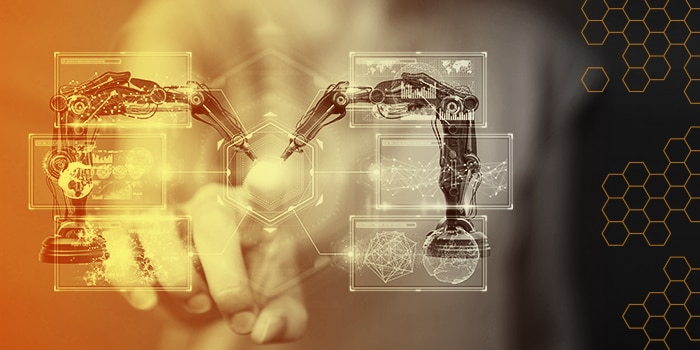Think about your last online order. If you’re a frequent online shopper and have created profiles for sites you visit often (
*raises hand*), then you’re probably familiar with customized recommendations. Based on your purchase history, location, and other factors, the website may suggest other items you might be interested in buying. And if you’re on the site long enough, chatbots may appear asking if you have questions or need assistance locating something. These are just two examples of how artificial intelligence (AI) and automation have made the consumer experience easier and created ways to help businesses understand their buying patterns and what they need.
IT service management (ITSM) benefits greatly from AI and automation. As digital transformation accelerates, a
panel of ITSM pros recently weighed in on what automation and AI can look like for business operations and service delivery and what the future holds for these smart technologies.
Combining AI and automation in the service desk
AI and
automation have become the pervasive force in what we’re looking for from our systems. They perform together, and in the words of Digital.ai Director and Insights Architect Joe Foley, “AI is just another tool to assist with automation.” Businesses are looking for ways to fulfill more requests, reduce and resolve disruptions quicker, and free up money and talent to shift resources. AI and automation can predefine processes, automate repetitive workflows, set reminders, filter, and tag projects, helping team members focus on other business needs.
“A lot of folks are being asked to constantly do more with less, especially IT teams,” said Melody Scheidler, Sr. Solutions Engineer at SolarWinds. “By continuing to invest in AI and making it more broadly available across organizations regardless of the size, it’s going to improve efficiencies and reduce costs.”
So, just how much are companies investing in these smart technologies? A decent chunk of change. According to
Forbes, the percentage of firms investing $50 million or more in AI initiatives is up to 64.8% this year from just 39.7% in 2018.
“AI is really about making your life easier,” Scheidler said. “I see it freeing up teams to move away from spending time on password resets and being able to focus on things that are actually broken. It allows them to take the time to do root-cause analysis on problems because that can be incredibly time consuming to figure out why something went wrong.”
Predicting downtimes before they happen
It’s not a matter of
if downtime will happen, but
when. Downtime can be caused by server or network outages, emergency changes, releases, etc. Knowing within minutes that an application may go down can save a business thousands of dollars.
That’s why IT teams invest in monitoring tools—network and systems monitoring, application performance monitoring, etc. The alerts generated by these systems help IT identify potential issues, but identifying is only step one. IT needs to respond to and resolve these issues quickly to minimize the impact on employees and/or customers. That’s where automation kicks in for the service desk.
If IT creates automation around specific sets of these monitoring alerts, they can automatically generate incidents from, say, critical alerts for internal applications or warnings for internal servers. It may not seem like much, but it immediately bridges communication between the service desk and network/applications teams. It allows for AI to recognize related incidents or associate them with a problem. Accelerating the ITIL lifecycle will give IT the headstart it needs to resolve these issues faster, limiting outages and saving the business time and money.
Using AI to automate risk and impact assessment
One of the biggest causes of downtime—especially when it comes to change management? Human error. Add in the power of AI to assess data, though, and now service providers can make informed decisions without having to manually look at downstream impacts. Automation built into the change management process helps minimize the possibility of risks.
“As organizations adopt continuous deployment and faster changes in general, it can be overwhelming for them,” said Foley. “Most DevOps processes haven’t matured to the point where they can take on that responsibility, so AI is a key answer to be able to automate that risk and impact assessment.”
In the case of an emergency change? No need to break glass. AI can suggest related configuration items (CIs) and reveal the complete downstream impact of any downtime or maintenance in the
configuration management database (CMDB).
Putting AI and automation to work
When getting started with new technologies, keep the ITIL guiding principle “
Start Where You Are” top of mind—or put it on a sticky note on your monitor as a constant reminder. Take stock of the solutions and tools already available. IT pros can get their teams acclimated with what’s available so when new AI and automation tools are introduced, it doesn’t feel as jarring to understand.
Think about ticket routing. If teams can introduce automated routing to the right queues, that can add up to a lot of valuable time and resources now available for other more pressing tasks. Scheidler made a great point that “even if you save a few minutes per ticket, you’re doing hundreds of tickets per week or month and that really adds time back in your technician’s day.”
Another quick win can be adding
self-service articles to the knowledge base so end users can resolve their own issues before even submitting a ticket. Creating articles based on FAQs or tickets commonly submitted builds a sturdy foundation for AI-powered suggestions. Take password resets, for example. If employees type keywords into the search function of the knowledge base, AI can kick in and suggest relevant articles that can guide end users to reset the password themselves.
Automation and AI
are the future of ITSM. These technologies help reduce time that would have been spent doing manual and repetitive tasks. Leveraging these capabilities, especially in the service desk, can ultimately drive a better user experience and increased productivity from service providers.




